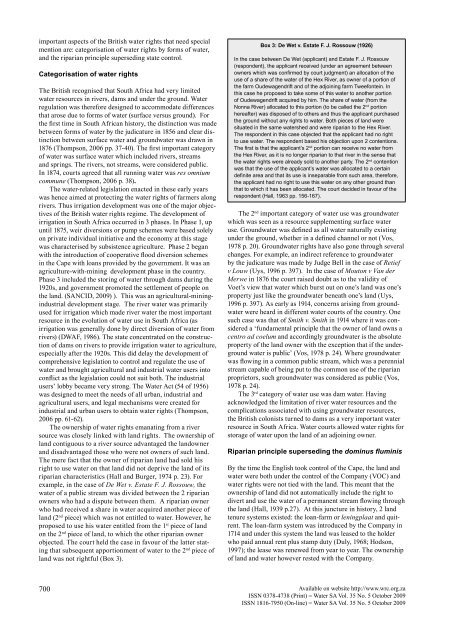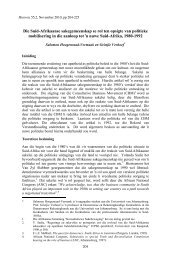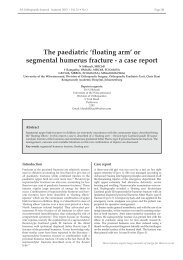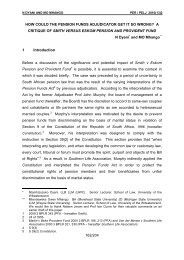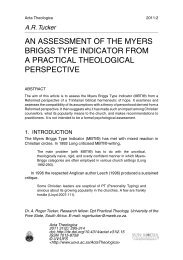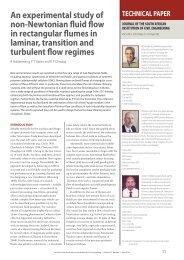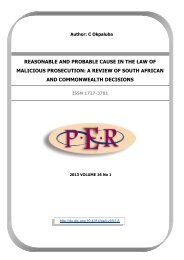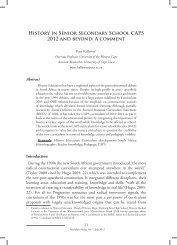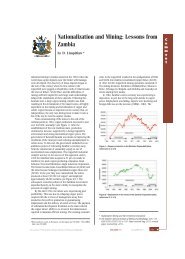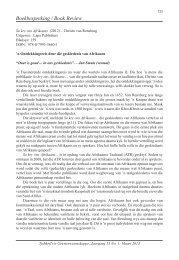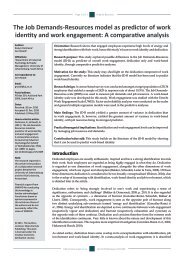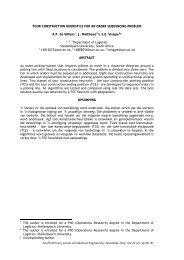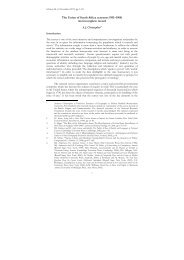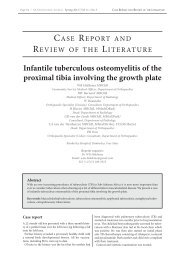A detailed analysis of evolution of water rights in South Africa: An ...
A detailed analysis of evolution of water rights in South Africa: An ...
A detailed analysis of evolution of water rights in South Africa: An ...
Create successful ePaper yourself
Turn your PDF publications into a flip-book with our unique Google optimized e-Paper software.
important aspects <strong>of</strong> the British <strong>water</strong> <strong>rights</strong> that need special<br />
mention are: categorisation <strong>of</strong> <strong>water</strong> <strong>rights</strong> by forms <strong>of</strong> <strong>water</strong>,<br />
and the riparian pr<strong>in</strong>ciple supersed<strong>in</strong>g state control.<br />
Categorisation <strong>of</strong> <strong>water</strong> <strong>rights</strong><br />
The British recognised that <strong>South</strong> <strong>Africa</strong> had very limited<br />
<strong>water</strong> resources <strong>in</strong> rivers, dams and under the ground. Water<br />
regulation was therefore designed to accommodate differences<br />
that arose due to forms <strong>of</strong> <strong>water</strong> (surface versus ground). For<br />
the first time <strong>in</strong> <strong>South</strong> <strong>Africa</strong>n history, the dist<strong>in</strong>ction was made<br />
between forms <strong>of</strong> <strong>water</strong> by the judicature <strong>in</strong> 1856 and clear dist<strong>in</strong>ction<br />
between surface <strong>water</strong> and ground<strong>water</strong> was drawn <strong>in</strong><br />
1876 (Thompson, 2006 pp. 37-40). The first important category<br />
<strong>of</strong> <strong>water</strong> was surface <strong>water</strong> which <strong>in</strong>cluded rivers, streams<br />
and spr<strong>in</strong>gs. The rivers, not streams, were considered public.<br />
In 1874, courts agreed that all runn<strong>in</strong>g <strong>water</strong> was res omnium<br />
commune (Thompson, 2006 p. 38).<br />
The <strong>water</strong>-related legislation enacted <strong>in</strong> these early years<br />
was hence aimed at protect<strong>in</strong>g the <strong>water</strong> <strong>rights</strong> <strong>of</strong> farmers along<br />
rivers. Thus irrigation development was one <strong>of</strong> the major objectives<br />
<strong>of</strong> the British <strong>water</strong> <strong>rights</strong> regime. The development <strong>of</strong><br />
irrigation <strong>in</strong> <strong>South</strong> <strong>Africa</strong> occurred <strong>in</strong> 3 phases. In Phase 1, up<br />
until 1875, weir diversions or pump schemes were based solely<br />
on private <strong>in</strong>dividual <strong>in</strong>itiative and the economy at this stage<br />
was characterised by subsistence agriculture. Phase 2 began<br />
with the <strong>in</strong>troduction <strong>of</strong> cooperative flood diversion schemes<br />
<strong>in</strong> the Cape with loans provided by the government. It was an<br />
agriculture-with-m<strong>in</strong><strong>in</strong>g development phase <strong>in</strong> the country.<br />
Phase 3 <strong>in</strong>cluded the stor<strong>in</strong>g <strong>of</strong> <strong>water</strong> through dams dur<strong>in</strong>g the<br />
1920s, and government promoted the settlement <strong>of</strong> people on<br />
the land. (SANCID, 2009) ). This was an agricultural-m<strong>in</strong><strong>in</strong>g<strong>in</strong>dustrial<br />
development stage. The river <strong>water</strong> was primarily<br />
used for irrigation which made river <strong>water</strong> the most important<br />
resource <strong>in</strong> the <strong>evolution</strong> <strong>of</strong> <strong>water</strong> use <strong>in</strong> <strong>South</strong> <strong>Africa</strong> (as<br />
irrigation was generally done by direct diversion <strong>of</strong> <strong>water</strong> from<br />
rivers) (DWAF, 1986). The state concentrated on the construction<br />
<strong>of</strong> dams on rivers to provide irrigation <strong>water</strong> to agriculture,<br />
especially after the 1920s. This did delay the development <strong>of</strong><br />
comprehensive legislation to control and regulate the use <strong>of</strong><br />
<strong>water</strong> and brought agricultural and <strong>in</strong>dustrial <strong>water</strong> users <strong>in</strong>to<br />
conflict as the legislation could not suit both. The <strong>in</strong>dustrial<br />
users’ lobby became very strong. The Water Act (54 <strong>of</strong> 1956)<br />
was designed to meet the needs <strong>of</strong> all urban, <strong>in</strong>dustrial and<br />
agricultural users, and legal mechanisms were created for<br />
<strong>in</strong>dustrial and urban users to obta<strong>in</strong> <strong>water</strong> <strong>rights</strong> (Thompson,<br />
2006 pp. 61-62).<br />
The ownership <strong>of</strong> <strong>water</strong> <strong>rights</strong> emanat<strong>in</strong>g from a river<br />
source was closely l<strong>in</strong>ked with land <strong>rights</strong>. The ownership <strong>of</strong><br />
land contiguous to a river source advantaged the landowner<br />
and disadvantaged those who were not owners <strong>of</strong> such land.<br />
The mere fact that the owner <strong>of</strong> riparian land had sold his<br />
right to use <strong>water</strong> on that land did not deprive the land <strong>of</strong> its<br />
riparian characteristics (Hall and Burger, 1974 p. 23). For<br />
example, <strong>in</strong> the case <strong>of</strong> De Wet v. Estate F. J. Rossouw, the<br />
<strong>water</strong> <strong>of</strong> a public stream was divided between the 2 riparian<br />
owners who had a dispute between them. A riparian owner<br />
who had received a share <strong>in</strong> <strong>water</strong> acquired another piece <strong>of</strong><br />
land (2 nd piece) which was not entitled to <strong>water</strong>. However, he<br />
proposed to use his <strong>water</strong> entitled from the 1 st piece <strong>of</strong> land<br />
on the 2 nd piece <strong>of</strong> land, to which the other riparian owner<br />
objected. The court held the case <strong>in</strong> favour <strong>of</strong> the latter stat<strong>in</strong>g<br />
that subsequent apportionment <strong>of</strong> <strong>water</strong> to the 2 nd piece <strong>of</strong><br />
land was not rightful (Box 3).<br />
Box 3: De Wet v. Estate F. J. Rossouw (1926)<br />
In the case between De Wet (applicant) and Estate F. J. Rossouw<br />
(respondent), the applicant received (under an agreement between<br />
owners which was confirmed by court judgment) an allocation <strong>of</strong> the<br />
use <strong>of</strong> a share <strong>of</strong> the <strong>water</strong> <strong>of</strong> the Hex River, as owner <strong>of</strong> a portion <strong>of</strong><br />
the farm Oudewagendrift and <strong>of</strong> the adjo<strong>in</strong><strong>in</strong>g farm Tweefonte<strong>in</strong>. In<br />
this case he proposed to take some <strong>of</strong> this <strong>water</strong> to another portion<br />
<strong>of</strong> Oudewagendrift acquired by him. The share <strong>of</strong> <strong>water</strong> (from the<br />
Nonna River) allocated to this portion (to be called the 2 nd portion<br />
hereafter) was disposed <strong>of</strong> to others and thus the applicant purchased<br />
the ground without any <strong>rights</strong> to <strong>water</strong>. Both pieces <strong>of</strong> land were<br />
situated <strong>in</strong> the same <strong>water</strong>shed and were riparian to the Hex River.<br />
The respondent <strong>in</strong> this case objected that the applicant had no right<br />
to use <strong>water</strong>. The respondent based his objection upon 2 contentions.<br />
The first is that the applicant’s 2 nd portion can receive no <strong>water</strong> from<br />
the Hex River, as it is no longer riparian to that river <strong>in</strong> the sense that<br />
the <strong>water</strong> <strong>rights</strong> were already sold to another party. The 2 nd contention<br />
was that the use <strong>of</strong> the applicant’s <strong>water</strong> was allocated to a certa<strong>in</strong><br />
def<strong>in</strong>ite area and that its use is <strong>in</strong>separable from such area, therefore,<br />
the applicant had no right to use this <strong>water</strong> on any other ground than<br />
that to which it has been allocated. The court decided <strong>in</strong> favour <strong>of</strong> the<br />
respondent (Hall, 1963 pp. 156-167).<br />
The 2 nd important category <strong>of</strong> <strong>water</strong> use was ground<strong>water</strong><br />
which was seen as a resource supplement<strong>in</strong>g surface <strong>water</strong><br />
use. Ground<strong>water</strong> was def<strong>in</strong>ed as all <strong>water</strong> naturally exist<strong>in</strong>g<br />
under the ground, whether <strong>in</strong> a def<strong>in</strong>ed channel or not (Vos,<br />
1978 p. 20). Ground<strong>water</strong> <strong>rights</strong> have also gone through several<br />
changes. For example, an <strong>in</strong>direct reference to ground<strong>water</strong><br />
by the judicature was made by Judge Bell <strong>in</strong> the case <strong>of</strong> Retief<br />
v Louw (Uys, 1996 p. 397). In the case <strong>of</strong> Mouton v Van der<br />
Merwe <strong>in</strong> 1876 the court raised doubt as to the validity <strong>of</strong><br />
Voet’s view that <strong>water</strong> which burst out on one’s land was one’s<br />
property just like the ground<strong>water</strong> beneath one’s land (Uys,<br />
1996 p. 397). As early as 1914, concerns aris<strong>in</strong>g from ground<strong>water</strong><br />
were heard <strong>in</strong> different <strong>water</strong> courts <strong>of</strong> the country. One<br />
such case was that <strong>of</strong> Smith v. Smith <strong>in</strong> 1914 where it was considered<br />
a ‘fundamental pr<strong>in</strong>ciple that the owner <strong>of</strong> land owns a<br />
centro ad coelum and accord<strong>in</strong>gly ground<strong>water</strong> is the absolute<br />
property <strong>of</strong> the land owner with the exception that if the underground<br />
<strong>water</strong> is public’ (Vos, 1978 p. 24). Where ground<strong>water</strong><br />
was flow<strong>in</strong>g <strong>in</strong> a common public stream, which was a perennial<br />
stream capable <strong>of</strong> be<strong>in</strong>g put to the common use <strong>of</strong> the riparian<br />
proprietors, such ground<strong>water</strong> was considered as public (Vos,<br />
1978 p. 24).<br />
The 3 rd category <strong>of</strong> <strong>water</strong> use was dam <strong>water</strong>. Hav<strong>in</strong>g<br />
acknowledged the limitation <strong>of</strong> river <strong>water</strong> resources and the<br />
complications associated with us<strong>in</strong>g ground<strong>water</strong> resources,<br />
the British colonists turned to dams as a very important <strong>water</strong><br />
resource <strong>in</strong> <strong>South</strong> <strong>Africa</strong>. Water courts allowed <strong>water</strong> <strong>rights</strong> for<br />
storage <strong>of</strong> <strong>water</strong> upon the land <strong>of</strong> an adjo<strong>in</strong><strong>in</strong>g owner.<br />
Riparian pr<strong>in</strong>ciple supersed<strong>in</strong>g the dom<strong>in</strong>us flum<strong>in</strong>is<br />
By the time the English took control <strong>of</strong> the Cape, the land and<br />
<strong>water</strong> were both under the control <strong>of</strong> the Company (VOC) and<br />
<strong>water</strong> <strong>rights</strong> were not tied with the land. This meant that the<br />
ownership <strong>of</strong> land did not automatically <strong>in</strong>clude the right to<br />
divert and use the <strong>water</strong> <strong>of</strong> a permanent stream flow<strong>in</strong>g through<br />
the land (Hall, 1939 p.27). At this juncture <strong>in</strong> history, 2 land<br />
tenure systems existed: the loan-farm or len<strong>in</strong>gplaat and quitrent.<br />
The loan-farm system was <strong>in</strong>troduced by the Company <strong>in</strong><br />
1714 and under this system the land was leased to the holder<br />
who paid annual rent plus stamp duty (Duly, 1968; Hodson,<br />
1997); the lease was renewed from year to year. The ownership<br />
<strong>of</strong> land and <strong>water</strong> however rested with the Company.<br />
700<br />
Available on website http://www.wrc.org.za<br />
ISSN 0378-4738 (Pr<strong>in</strong>t) = Water SA Vol. 35 No. 5 October 2009<br />
ISSN 1816-7950 (On-l<strong>in</strong>e) = Water SA Vol. 35 No. 5 October 2009


